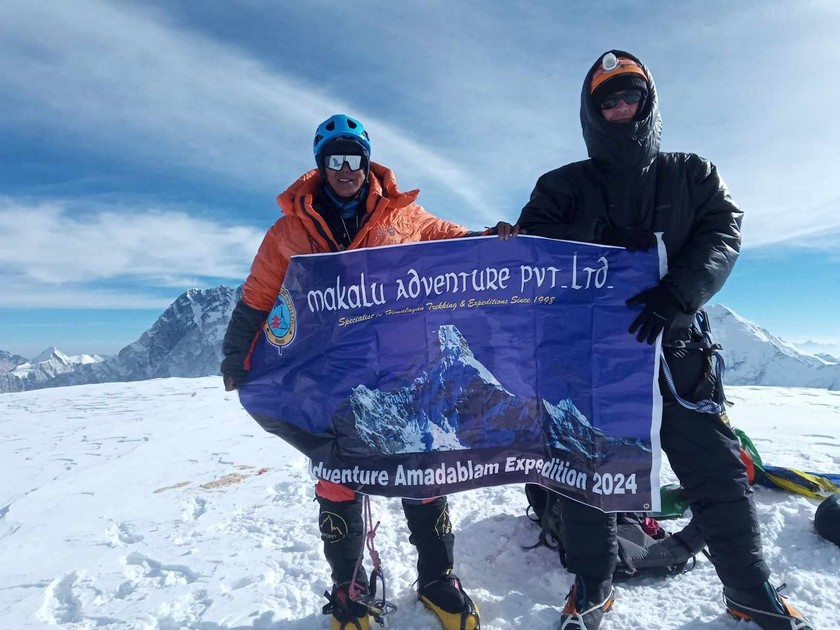“It is not the mountains we conquer, but ourselves” – Sir Edmund Hillary.
Climb Mount Everest with GoTravelDaily
Even now no one is quite sure if Mt. Everest was first climbed in 1924 by George Mallory and Andrew Irvine, but we do know, for sure, that it was climbed on the 29th of May 1953 by Tenzing Norgay Sherpa and Edmund Hillary. Since then, there have been numerous ascents; to January 2024 11,996 by all routes, 8,350 from Nepal. Sadly, there have also been many fatalities, 217 on the Nepal side, 123 on the Tibet side. For many years after the 1953 expedition the Nepalese government only allowed one team per season to attempt the climb but as adventure tourism expanded, they allowed several teams on the mountain at the same time, in 2000 80 people made it to the summit, in 2022 it was 658, clients and guides. Is Mt. Everest for you – a good question? Nowadays you don’t need to be a highly skilled mountaineer to climb Mt. Everest, before the clients arrive at Base Camp a team of skilled Sherpa climbers make and fix the route from the bottom of the Khumbu IceFall to Camp 1, and again up the Lhotse Face and Southeast Ridge to the summit.
You do, however, need to be extremely fit and have the right mental attitude. You should be a ‘mountain person,’ at home in the mountains and ideally have climbed lesser peaks, perhaps Island Peak (6,165m), Ama Dablam (6,812m) or better still Mt. Manaslu (8,163m). Many operators facilitate expeditions to Mt. Everest, but we believe we have a near-perfect itinerary, honed over many years. The key to a successful ascent is planning and preparation, and it starts well before the client reaches Base Camp. Instead of rushing up to Base Camp, we encourage our clients to take time for acclimatization and to revise skills needed on the mountain. Having spent a couple of days in Kathmandu, checking equipment and attending official briefings, etc.
The team is ready for the ‘exciting’ flight to Lukla, the gateway to the Khumbu. From there, it is a two-day hike to Namche Bazaar, the unofficial Sherpa Capital. From Namche, our itinerary differs from the norm, the norm being two nights in Namche for acclimatization and then following the tourist trail to Base Camp. We do spend two nights in Namche but then we head up the Dudh Koshi Nadi to Gokyo for two further days of acclimatization. On day one, a hike towards Cho You and on day two the ascent of Gokyo Ri (5,360). From Gokyo, we then cross the Cho La Pass (5,420m) to Lobuche East Base Camp. Lobuche East is a 6,119m non-technical peak and is perfect for topping up mountain fitness, acclimatization, and revising skills that will be required on Mt. Everest. This phase of the Everest expedition can take two or three days depending on the client’s ability and conditions. When all are confident, the team will move to Everest Base Camp via Lobuche and Gorak Shep.

The time normally spent at Everest Base Camp can be reduced because our clients will be acclimatized to Base Camp altitude (5,364m), in addition, they will already have been to over 6,000m, at least once, the altitude of Camp 1. Under the care of our experienced guides, the climbing phase begins. First, there is the Khumbu Icefall to negotiate, by far the most hazardous section of the climb. Crossing crevasses on ladders is never easy, but this is something our clients will have practiced on Lobuche East and again at Everest Base Camp. Over a period of two to three weeks, clients, escorted by guides, do rotations on the mountain, gradually climbing higher, spending a night or two at Camp 1 (6,065m), Camp 2 (6,400m), and Camp 3 (7,100m) before returning to Base Camp to rest and recuperate.
When the client and guide feel the time is right, they will ascend, through C1, C2, and C3 to Camp 4 on the South Col at 7,925m, client and guide will now be using supplementary oxygen. The South Col is not the sort of place you want to spend much time, the virtual oxygen level is down to about 20%, it is bitterly cold, and can be extremely windy! Ideally, clients will spend just one night in C4 before the summit push and one more on the descent. The push for the summit normally starts at about midnight, the plan being to reach the summit (8,848m) at about 8 am, allowing plenty of time to descend safely to C4. Client and guide will be using oxygen, and the guide will carry at least one spare cylinder.
Having returned safely to C4, the guide will make sure the client hydrates, rests, and eats. If all is well, the client and guide will descend to Base Camp in two days, a night spent at C2 and another at C1. It is advisable to spend the night at C1 and negotiate the Ice Fall early in the day when it is at its most stable. Having safely returned to Base Camp, clients have a choice; they can walk-out to Lukla for the return flight to Kathmandu, or they can, at additional cost, fly out by helicopter. We recommend walking out slowly, relaxing, and recounting with others what has been achieved.
- Next Win a 10-Day All-Inclusive Greek Island Adventure for Two!





